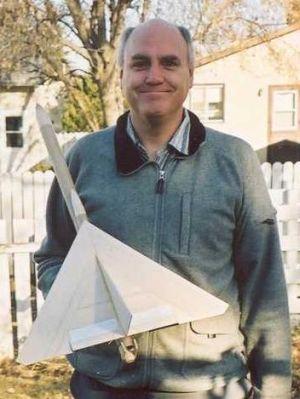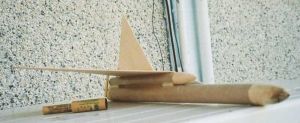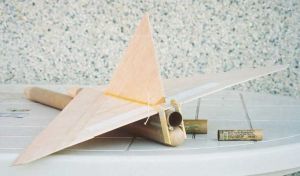| Construction Rating: | starstarstar_borderstar_borderstar_border |
| Flight Rating: | starstarstarstarstar_border |
| Overall Rating: | starstarstarstarstar_border |
| Manufacturer: | Clone |

Brief:
D-powered rocket glider
Construction:
The parts list:
- 1 nose cone, BT-55, tangent ogive, 3.125" length, 3/8" tenon (BNC55AA-ish)
- 1 nose cone, BT-50, tangent ogive, 3" length, 3/8" tenon (BNC50K-ish)
- 1 body tube, BT-55, 14" length
- 1 body tube, BT-55, 11" length
- 1 body tube, BT-50, 14" length
- 2 launch lugs, 1/8" diameter
- 1 motor block for 24 mm motor
- 1 retainer ring, 1/8" slice of TC-55 tube coupler
- 1 elastic or rubber band, about 1.2 mm wide, 6" length
- 2 spruce pieces, 1/8" x 1/2" x 1-1/16"
- 2 spruce pieces, 1/8" x 1/2" x 2-1/16"
- 2 balsa sheets, 1/8" x 4" x 36"
- 1 "baffle plug" - 2" length of solid balsa cylinder to fit inside BT-55
- 1 "blow out plug" - Made from 2.5" length of solid balsa cylinder to fit inside BT-55. Rear 3/4" fits BT-55. Middle 1.25" fits into TC-55 coupler. Forward 1/2" tapers to 1" diameter.
- 2 elevon hinges, 4-1/2" x 1", cut from a Tyvek envelope

The downloaded plan set includes images of the printed material from the original kit, It includes additional photos of the collection of kit parts, the round balsa parts, the flat balsa parts, and an aftermarket part sheet that describes part details and dimensions for a wing segment. The photographs give a good idea what each part should look like. This is quite important for the round parts because none of these parts are off-the-shelf items. The original kit printed instructions include an exploded drawing of the entire model, a set of assembly drawings, and step-by-step instructions for each assembly drawing. The instructions are quite clear, and the assembly drawings illustrate what needs to be done in each step fairly clearly, however, the assembly drawings are generally not drawn to scale.
There are some serious "gotcha's" with the downloaded plans that must be taken care of during initial parts fabrication. First, the descriptions of the "blow-out plug" in the round-part photo and in the aftermarket parts list specify a taper that cannot work. The forward end of the plug must taper to 1", NOT 0.75"! This is because the elevon hold-downs mounted on the plug must straddle a BT-50 tube, NOT a BT-20 tube. Second, the lengths of the BT-50 and BT-55 body tubes are possible, but they can't yield the model shown by the original kit insert or in the Kopter catalog (found at Sven Knudson's Ninfinger website). From assembly figures 5 and 14, the correct BT-50 and rear BT-55 tubes can be deduced to be 14" long, NOT 18". From the model specs and figure 5, the forward BT-55 tube must be 11" long, NOT 8". Third, the dimensions for Wing Part A on the aftermarket parts list are not consistent. That is, there are too many dimensions and they don't add up. I recommend disregarding the 10-5/16" dimension while keeping the others.
 I used a plastic "toy lathe" to turn the balsa nose cones, baffle plug, and blow-out plug. The lathe is a Toymax Toolmaster Workshop that, unfortunately, has been OOP since around 1997. Without a lathe, you should be able to order the nose cones and baffle plug from Balsa Machining Services. The blow-out plug should be doable too, if you figure out the dimensions to specify.
I used a plastic "toy lathe" to turn the balsa nose cones, baffle plug, and blow-out plug. The lathe is a Toymax Toolmaster Workshop that, unfortunately, has been OOP since around 1997. Without a lathe, you should be able to order the nose cones and baffle plug from Balsa Machining Services. The blow-out plug should be doable too, if you figure out the dimensions to specify.
Instead of using 3" wide flats, I used 4" wide balsa flats for the wings and rudder. To do this, I drew the full-scale outlines of the completed wing and rudder, based on given patterns, then divided them up into 4" strips. I feel that this lead to simplified assembly by reducing the number of joints that needed fitting together.
Once all of the parts had been fabricated, following the assembly instructions was straightforward but still posing some interesting challenges. Matching duct slots had to be cut into different caliber 14" tubes, then had to be carefully sealed together with glue joints and fillets. The wing and rudder parts needed careful trimming for precise fit.
I
Related Products
Sponsored Ads
 |
 |











